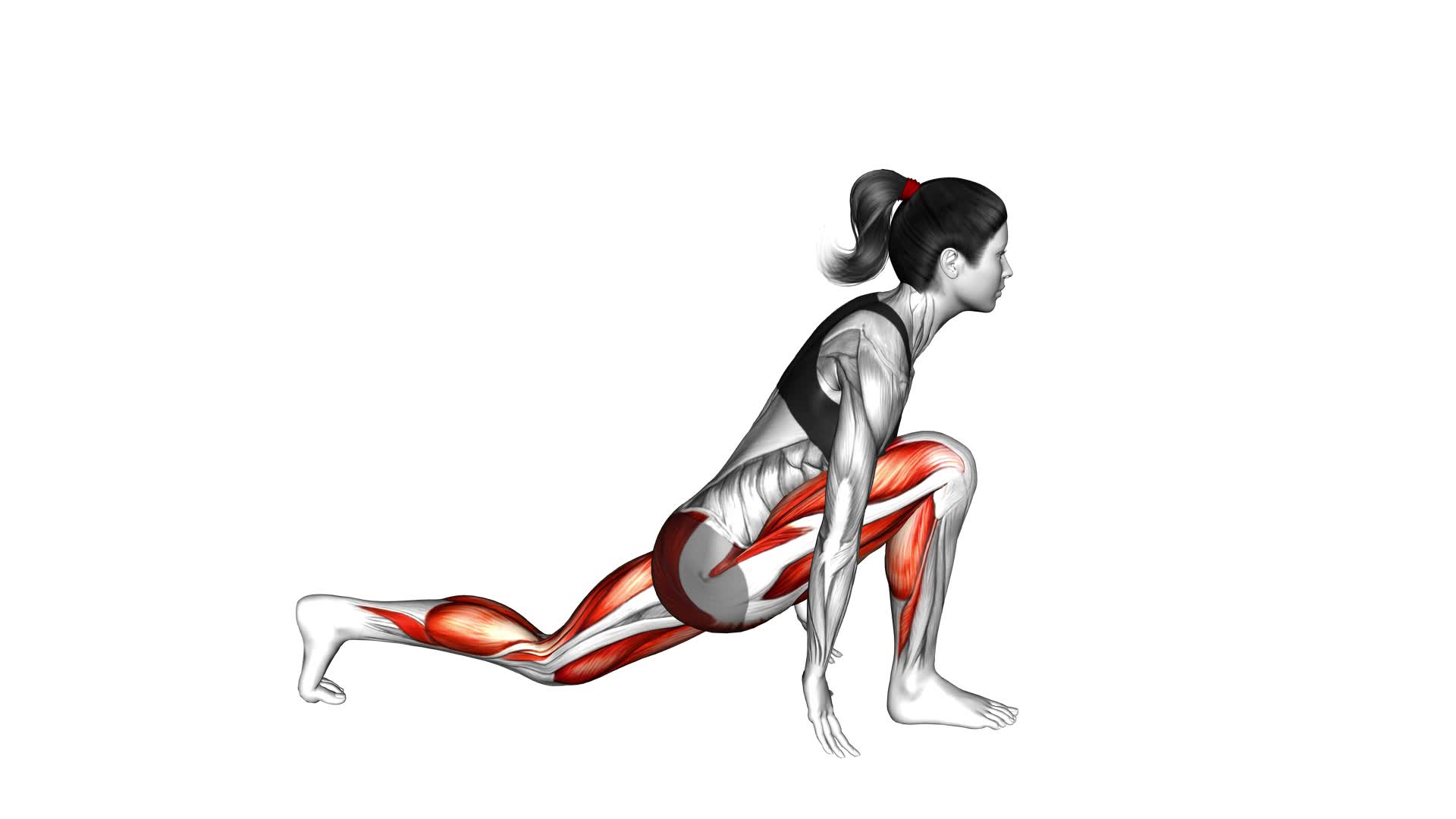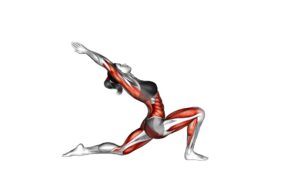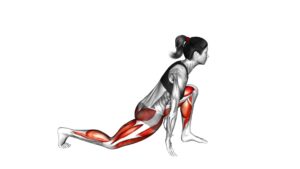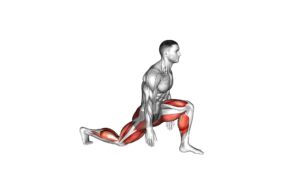Low Lunge (female) – Video Exercise Guide & Tips

Get ready to tone and strengthen your lower body with the low lunge exercise. This video exercise guide and tips are specifically designed for females like you.
Watch This Exercise Video
Learn the proper form and technique, discover modifications for different fitness levels, and avoid common mistakes.
Incorporate the low lunge into your workout routine for maximum results.
Let's get started!
Key Takeaways
- Low lunge can improve flexibility and strengthen lower body muscles.
- It targets quadriceps, hamstrings, glutes, and hip flexors.
- Proper form and technique, such as keeping the front knee directly above the ankle and engaging core muscles, are important to prevent injuries.
- The exercise can be modified for different fitness levels, with beginners starting at a higher lunge position and advanced individuals incorporating lower back knee positions, weights or resistance bands, and plyometric jumps.
Benefits of Low Lunge for Females
Experience the numerous benefits of the low lunge exercise for women, including improved flexibility, strengthened lower body muscles, and increased hip mobility.
The low lunge is a highly effective exercise that targets the muscles in the legs, hips, and core. By assuming a lunge position with one knee on the ground and the other leg extended behind, you engage the quadriceps, hamstrings, glutes, and hip flexors. This exercise helps to lengthen and strengthen these muscles, leading to improved flexibility and increased strength in the lower body.
In addition to its muscle-strengthening benefits, the low lunge also promotes increased hip mobility. As you lower your body into the lunge position, you stretch the hip flexors, which can become tight and stiff from prolonged sitting or inactivity. Regularly performing the low lunge can help to alleviate hip tightness and improve overall hip mobility.
However, it's important to take certain precautions when performing the low lunge exercise. If you have any knee or hip injuries, it's best to consult with a healthcare professional before attempting this exercise. Additionally, listen to your body and avoid any movements that cause pain or discomfort.
Now that you understand the benefits and precautions of the low lunge exercise, let's dive into the proper form and technique to ensure you get the most out of this exercise.
Proper Form and Technique
To ensure you get the most out of the low lunge exercise, it's important to maintain proper form and technique. This will help you maximize the benefits of the exercise and prevent injuries. One common mistake is letting your front knee extend past your toes, which can put excessive strain on your knee joint. To avoid this, make sure to keep your front knee directly above your ankle.
Another common mistake is collapsing your chest and rounding your back. Instead, engage your core muscles and keep your chest lifted throughout the exercise. Additionally, it's important to maintain a steady and controlled movement, avoiding any jerking or bouncing motions.
Proper form and technique can be modified based on your fitness level and specific needs. For beginners or those with limited flexibility, you can use blocks or props under your hands to provide support and maintain balance. If you have knee issues, you can place a cushion or folded towel under your back knee for added comfort. As you become more advanced, you can increase the depth of your lunge or add weights to challenge your muscles further.
Now that you understand the importance of proper form and technique, let's move on to the next section where we'll discuss modifications for different fitness levels.
Modifications for Different Fitness Levels
How can you modify the low lunge exercise to accommodate different fitness levels? Whether you're a beginner or an advanced fitness enthusiast, there are progression options and modifications available to suit your needs.
For beginners, starting with a higher lunge position can make the exercise more accessible. Instead of placing your back knee on the ground, keep it lifted and focus on maintaining a strong and stable stance. This modification allows you to build strength and stability in your lower body without putting too much strain on your muscles.
As you become more comfortable with the low lunge, you can gradually lower your back knee towards the ground. This progression option helps to deepen the stretch and increase the activation of your leg muscles. You can also try adding light dumbbells or resistance bands to challenge your upper body and core strength.
For advanced fitness levels, you can further intensify the low lunge by adding a plyometric element. Instead of stepping back into the lunge position, explosively jump and switch legs mid-air. This variation increases the cardiovascular demand and engages more muscles in your lower body.
Common Mistakes to Avoid
To avoid common mistakes in the low lunge exercise, ensure that you maintain proper form and alignment throughout the movement.
One common mistake isn't aligning your front knee properly. Make sure that your front knee is directly above your ankle and doesn't extend past your toes. This will help prevent unnecessary strain on your knee joint.
Another mistake to avoid is collapsing your back leg. Keep your back leg engaged and straight, with your heel lifted off the ground. This will help stabilize your body and engage the muscles in your back leg.
Additionally, watch out for leaning too far forward or rounding your back. Keep your torso upright and lengthen your spine throughout the movement. This will help protect your lower back and maintain proper alignment.
Lastly, remember to engage your core muscles throughout the exercise to support your body and maintain stability.
Tips for Incorporating Low Lunge Into Your Workout Routine
To incorporate low lunge into your workout routine, start by choosing a comfortable and spacious area to perform the exercise. This will allow you to have enough room to move and stretch properly. Once you have found the right space, follow these tips to get the most out of your low lunge:
- Warm up: Prior to starting the low lunge, it's important to warm up your muscles. This can be done through light cardio exercises or dynamic stretches.
- Proper form: Maintain proper form throughout the exercise. Make sure your front knee is directly above your ankle and your back knee is hovering just above the ground. Keep your torso upright and engage your core muscles.
- Breathe: Remember to breathe deeply and rhythmically while performing the low lunge. Inhale as you lower into the lunge and exhale as you rise back up.
- Modifications and variations: As you become more comfortable with the low lunge, you can modify the exercise by adding weights or incorporating a twist. These variations can help increase the intensity and challenge your muscles in new ways.
Frequently Asked Questions
How Many Calories Does a Low Lunge Exercise Burn?
The low lunge exercise is a great way to burn calories and aid in weight loss. By incorporating this exercise into your routine, you can expect to see an increase in calorie burn.
The benefits of the low lunge for weight loss include strengthening and toning the legs, hips, and core muscles. It also helps improve balance and flexibility.
Can Low Lunge Help With Improving Flexibility?
Low lunge is a great exercise to improve flexibility. By stretching your hip flexors and quadriceps, it increases your range of motion and helps you achieve better balance.
Additionally, low lunge can also help reduce lower back pain by strengthening the muscles in your core and lower body. Incorporating this exercise into your routine won't only enhance your flexibility but also contribute to overall strength and stability.
Is It Safe to Do Low Lunge During Pregnancy?
During pregnancy, it's important to consider the safety of exercises like the low lunge. It's always a good idea to consult with your healthcare provider before starting any new exercise routine.
Modifications can be made to make it safer during pregnancy, such as using a support or reducing the depth of the lunge. Prioritizing stability and avoiding excessive stretching is key.
Always listen to your body and stop if you feel any discomfort.
Can Low Lunge Help to Strengthen the Core Muscles?
Yes, low lunge can definitely help strengthen your core muscles. By engaging your abdominal muscles and stabilizing your body, this exercise targets your core and improves its strength and stability.
It also helps to lengthen and stretch the hip flexors, which can be beneficial for runners.
If you're pregnant or have any concerns, make sure to consult with a medical professional and consider low lunge modifications that are safe for your condition.
Is There Any Specific Breathing Technique to Follow During Low Lunge?
During a low lunge, it's important to focus on your breathing technique. By inhaling deeply through your nose and exhaling through your mouth, you can enhance the benefits of this exercise.
This controlled breathing helps to oxygenate your muscles and calm your mind. Remember to stay mindful and listen to your body, making any necessary modifications to suit your comfort level.
Conclusion
Incorporating low lunges into your workout routine can be highly beneficial for females. This exercise helps improve lower body strength, flexibility, and balance.
By maintaining proper form and technique, you can maximize the effectiveness of this exercise. Modifying the intensity level according to your fitness capabilities is important to prevent injuries.
Avoid common mistakes such as leaning forward or allowing the knee to go beyond the toes.
Follow these tips to make the most out of your low lunge workouts.

Author
Years ago, the spark of my life’s passion ignited in my mind the moment I stepped into the local gym for the first time. The inaugural bead of perspiration, the initial endeavor, the very first surge of endorphins, and a sense of pride that washed over me post-workout marked the beginning of my deep-seated interest in strength sports, fitness, and sports nutrition. This very curiosity blossomed rapidly into a profound fascination, propelling me to earn a Master’s degree in Physical Education from the Academy of Physical Education in Krakow, followed by a Sports Manager diploma from the Jagiellonian University. My journey of growth led me to gain more specialized qualifications, such as being a certified personal trainer with a focus on sports dietetics, a lifeguard, and an instructor for wellness and corrective gymnastics. Theoretical knowledge paired seamlessly with practical experience, reinforcing my belief that the transformation of individuals under my guidance was also a reflection of my personal growth. This belief holds true even today. Each day, I strive to push the boundaries and explore new realms. These realms gently elevate me to greater heights. The unique combination of passion for my field and the continuous quest for growth fuels my drive to break new ground.







